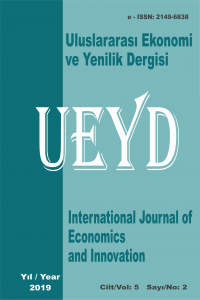Öz
Bu çalışmada, Türkiye ekonomisi cari açığının
sürdürülebilirliği 1992:I-2017:IV dönemine ait çeyreklik cari denge Gayrisafi
Yurtiçi Hasıla (GDP) oranı ve 1992:01-2017:12 dönemine ait aylık reel cari
denge ve kişi başına reel cari denge olmak üzere üç ayrı seriye uygulanan
kırılmalı ve kırılmasız birim-kök testleri ile analiz edilmektedir. Kırılmasız
birim-kök test sonuçları genel olarak serilerin durağan olmadığını, tersine
kırılmalı birim-kök test sonuçları ise genel olarak serilerin durağan ve
dolayısıyla cari açığın sürdürülebilir olduğunu göstermektedir. Her ne kadar
Türkiye ekonomisi cari açığı kırılmaların dikkate alınması durumunda durağan
bulunsa da, durağan bulunan “(Cari Açık)/GDP” serisinin ortalaması çok yüksek
ve literatürde kriz eşiği olarak görülen oranlara oldukça yakındır. Bu nedenle
cari açık önemli bir sorun olarak ele alınmalı ve göz ardı edilmemelidir.
Anahtar Kelimeler
Cari Açık Sürdürülebilirlik Türkiye Ekonomisi Birim Kök Testleri
Kaynakça
- Bhargava, A. (1986). On the theory of testing for unit roots in observed time series. Review of Economic Studies, 53(3), 369-384.
- Campbell, J. Y. ve Shiller, R. J. (1987). Cointegration and tests of present value models. Journal of Political Economy, 95(5), 1062-1088.
- Cashin, P. ve McDermott, C. J. (1998). Are Australia's current account deficits excessive? Economic Record, 74(227), 346-361.
- Chen, S. W. (2011). Current account deficits and sustainability: Evidence from the OECD countries. Economic Modelling, 28(4), 1455-1464.
- Dickey, D. A. ve Fuller, W. A. (1979). Distribution of the estimators for autoregressive time series with a unit root. Journal of the American Statistical Association, 74(366), 427-431.
- Elliott, G., Rothenberg, T. J. ve Stock, J. H. (1996). Efficient tests for an autoregressive unit root. Econometrica, 64(4), 813-836.
- Fountas, S. ve Wu, J. L. (1999). Are the U.S. current account deficits really sustainable? International Economic Journal, 13(3), 51-58.
- Ghosh, A. R. (1995). International capital mobility amongst the major industrialised countries: Too little or too much? The Economic Journal, 105(428), 107-128.
- Ghosh, A. R. ve Ostry, J. D. (1995). The current account in developing countries: A perspective from the consumption-smoothing approach. The World Bank Economic Review, 9(2), 305-333.
- Hakkio, C. S. ve Rush, M. (1991). Is the budget deficit “too large?” Economic Inquiry, 29(3), 429-445.
- Husted, S. (1992). The emerging US current account deficit in the 1980s: A cointegration analysis. The Review of Economics and Statistics, 74(1), 159-166.
- Kwiatkowski, D., Phillips, P. C., Schmidt, P. ve Shin, Y. (1992). Testing the null hypothesis of stationarity against the alternative of a unit root: How sure are we that economic time series have a unit root? Journal of Econometrics, 54(1-3), 159-178.
- Lee, J. ve Strazicich, M.C. (2003). Minimum Lagrange multiplier unit root test with two structural breaks. Review of Economics and Statistics, 85(4), 1082-1089.
- Lee, J. ve Strazicich, M. C. (2004). Minimum LM unit root test with one structural break. Manuscript, Department of Economics, Appalachian State University, 1-16.
- Liu, P. C. ve Tanner, E. (1996). International intertemporal solvency in industrialized countries: Evidence and implications. Southern Economic Journal, 62(3), 739-749.
- MacKinnon, J.G. (1996). Numerical distribution functions for unit root and cointegration tests. Journal of Applied Econometrics, 11(6), 601-618.
- Matsubayashi, Y. (2005). Are US current account deficits unsustainable? Testing for the private and government intertemporal budget constraints. Japan and the World Economy, 17(2), 223-237.
- Milesi-Ferretti, G. M. ve Razin, A. (1996). Sustainability of persistent current account deficits. National Bureau of Economic Research (NBER) Working Paper No. 5467, 1-31.
- Newey, W. K. ve West, K. D. (1994). Automatic lag length selection in covariance matrix estimation. Review of Economic Studies, 61(4), 631-653.
- Ng, S. ve Perron, P. (1995). Unit root tests in ARMA models with data-dependent methods for the selection of the truncation lag. Journal of the American Statistical Association, 90(429), 268-281.
- Ng, S. ve Perron, P. (2001). Lag length selection and the construction of unit root tests with good size and power. Econometrica, 69(6), 1519-1554.
- Phillips, P. C. B. (1987). Time series regression with a unit root. Econometrica, 55(2), 277-301.
- Phillips, P. C. B. ve Perron, P. (1988). Testing for a unit root in time series regression. Biometrika, 75(2), 335-346.
- Sivri, U. ve Seven, B. (2017). Ortalama tüketim eğilimi durağan mıdır? Türkiye ekonomisi için bir zaman serisi analizi. Anadolu İktisat ve İşletme Dergisi, 1(1), 50-65.
- Trehan, B. ve Walsh, C. (1991). Testing intertemporal budget constraints: Theory and applications to U.S. federal budget and current account deficits. Journal of Money, Credit and Banking, 23(2), 206-223.
- TÜİK (2018a). Konularına göre istatistikler, Nüfus ve demografi, Genel nüfus sayımları. http://www.tuik.gov.tr/PreTablo.do?alt_id=1059 (Erişim: 24.02.2018).
- TÜİK (2018b). Konularına göre istatistikler, Nüfus ve demografi, Adrese dayalı nüfus kayıt sistemi. http://www.tuik.gov.tr/PreTablo.do?alt_id=1059 (Erişim: 24.02.2018).
- Wickens, M. R. ve Uctum, M. (1993). The sustainability of current account deficits: A test of the US intertemporal budget constraint. Journal of Economic Dynamics and Control, 17(3), 423-441.
- Wu, J. L. (2000). Mean reversion of the current account: Evidence from the panel data unit-root test. Economics Letters, 66(2), 215-222.
- Wu, J. L., Chen, S. L. ve Lee, H. Y. (2001). Are current account deficits sustainable? Evidence from panel cointegration. Economics Letters, 72(2), 219-224
Ayrıntılar
| Birincil Dil | Türkçe |
|---|---|
| Konular | Ekonomi |
| Bölüm | Araştırma Makaleleri |
| Yazarlar | |
| Yayımlanma Tarihi | 24 Ekim 2019 |
| Gönderilme Tarihi | 29 Mayıs 2019 |
| Yayımlandığı Sayı | Yıl 2019 Cilt: 5 Sayı: 2 |
Cited By
Sustainability Analysis of Current Account In the European Union Countries: FADF and FKSS Unit Root Tests
Uluslararası Ekonomi ve Yenilik Dergisi
Yılmaz TOKTAŞ
https://doi.org/10.20979/ueyd.915113
MINT ÜLKELERİNDE CARİ İŞLEMLER AÇIĞI SÜRDÜRÜLEBİLİR Mİ?
Yönetim ve Ekonomi Araştırmaları Dergisi
https://doi.org/10.11611/yead.1000464
Uluslararası Ekonomi ve Yenilik Dergisi
Karadeniz Teknik Üniversitesi, İİBF, İktisat Bölümü, 61080, Trabzon/Türkiye
https://dergipark.org.tr/en/pub/ueyd
This work is licensed under a Creative Commons Attribution 4.0 International License.

